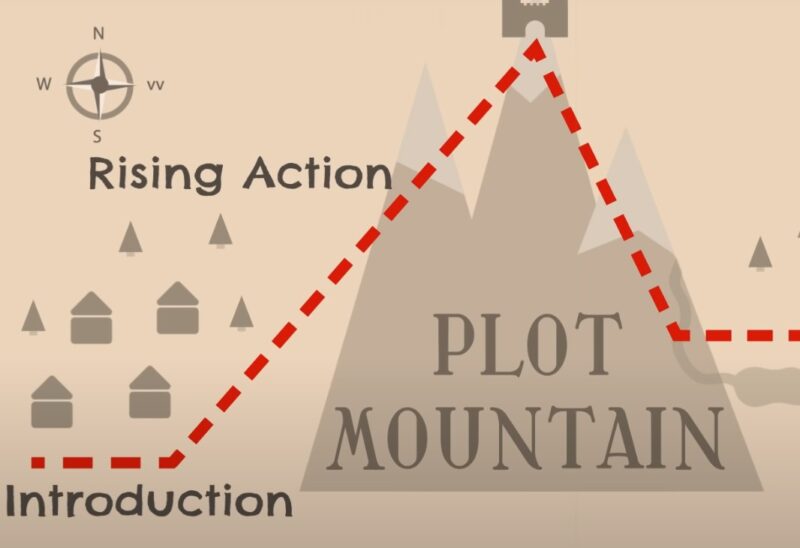The plot is the foundation of any story, a structured sequence of events that enthralls readers and carries them through the narrative. A well-crafted plot is essential for engaging storytelling, weaving characters, settings, and events into a cohesive and compelling experience.
Most stories, from classic fairy tales to modern novels, follow a specific plot structure. Each part plays a crucial role in developing the story, contributing to its overall impact and effectiveness. To illustrate these elements in a practical context, let’s consider the well-known story of the “Three Little Pigs.”
By dissecting this story, we can gain a clearer understanding of how each component of the plot functions and why each is vital to the story’s success.
What are the Main Elements?
Knowing exactly what are the main elements in the plot of the story makes it easier for the writer to create a structure that will lead to successful writing.
1. Exposition
The exposition is where a story begins, setting the stage for the narrative. In this initial phase, the writer introduces the main characters, the setting, and the central conflict or problem that will drive the plot.
This part is crucial as it establishes the groundwork for everything that follows, providing the reader with the necessary context to understand the unfolding events.
In the story of the “Three Little Pigs,” the exposition introduces us to a couple of elements:
- Three pig characters and the world they inhabit.
- We learn about their personalities and the challenge they face – building houses to protect themselves from the big bad wolf.
- This setup is essential as it not only familiarizes us with the protagonists and the antagonists but also sets up the central conflict that propels the story forward.
A well-crafted exposition draws the reader in, creating a connection with the characters and a curiosity about their fate. It lays out the initial situation that will evolve as the plot progresses, setting the tone for the reader’s journey through the narrative.
2. Conflict

Conflict is the driving force of any story, creating tension and interest that keeps the reader engaged. It is the primary problem or challenge that the protagonist must face and overcome. The conflict is often directly tied to the main character’s goals or desires, setting up a struggle that forms the core of the narrative.
The conflict is clear:
- The pigs must build homes strong enough to withstand the wolf’s attempts to blow them down.
- This conflict is both external (the threat posed by the wolf) and internal (the pigs’ need to be resourceful and brave).
- The story revolves around this central challenge, with each pig’s approach to building their house reflecting their character and contributing to the unfolding drama.
Conflict is essential in a plot as it introduces suspense and a sense of urgency. It challenges the characters, forcing them to grow and adapt, and it keeps the reader invested in the outcome of the story. Without conflict, a narrative would lack depth and purpose, failing to engage the reader’s emotions and interest.
3. Rising Action
Rising action encompasses the series of events that increase tension and build up the conflict leading to the climax. It is during this phase that the stakes are raised, and the characters are put to the test. The rising action adds complexity to the narrative, introducing new challenges, obstacles, and developments that heighten the sense of anticipation.
The rising action is seen as each pig builds their house with varying degrees of effort and materials. The tension escalates with the wolf’s arrival and his successive attempts to blow down the houses.
Each encounter with the wolf intensifies the conflict, showcasing the varying resilience of the pigs’ houses and leading up to the critical moment of confrontation. The reader’s interest and emotional investment grow during this phase, as the outcome of the pigs’ efforts becomes increasingly uncertain.
Rising action is vital in a story as it not only develops the plot but also deepens the reader’s understanding of the characters and their motivations. It creates a dynamic narrative that propels the story forward, building momentum towards the climax.
4. Climax
The climax is the peak of the story’s action and tension. It is the moment when the main character confronts the primary conflict head-on. The climax is often the most dramatic part of the narrative, presenting a turning point where the outcome of the conflict is decided.
The climax occurs when the wolf attempts to blow down the third pig’s brick house. This moment is the culmination of the story’s tension, as it becomes clear whether the pig’s efforts will be successful in thwarting the wolf. The climax tests the characters’ resolve and ultimately reveals their true nature.
The climax is crucial because it delivers the story’s most intense and emotional moment. It is the point where the narrative’s built-up tension is released, providing a sense of catharsis or revelation to the reader. The climax is often what the reader remembers most vividly, making it a key element of an effective plot.
5. Falling Action

Following the climax, the falling action involves resolving the story’s central conflict and slowing down the pace of the narrative. This part of the plot leads to the resolution, tying up loose ends and moving towards the story’s conclusion.
The falling action occurs after the wolf fails to blow down the brick house. The story begins to wind down, with the wolf’s defeat becoming evident. The actions of the pigs and the consequences of their choices are clarified, leading to a resolution of the conflict.
The falling action is important as it provides a bridge from the climax to the resolution. It offers the reader a chance to process the climax’s events and prepares them for the story’s conclusion. This part of the plot ensures that the narrative concludes in a coherent and satisfying manner.
6. Resolution
The resolution brings the story to its conclusion, providing closure to the plot and its characters. It is where the story’s final outcome is revealed, and the remaining questions are answered. The resolution leaves the reader with a sense of completion and understanding of the narrative’s overall message.
The resolution is seen when the pigs emerge victorious, having outsmarted the wolf. The story concludes with a moral lesson about the importance of hard work and preparation. The resolution provides a satisfying end to the narrative, leaving the reader with a clear understanding of the story’s message and its implications.
The resolution is essential in a plot as it concludes the story in a way that feels appropriate and fulfilling. It ensures that the reader leaves the story with a sense of satisfaction, having fully experienced the journey the characters have undertaken. However, we must say that a cliffhanger can be equally as effective, when done properly, of course.
Point of View

Point of view is another prominent factor you should consider when writing a story. It can set the tone that will follow the character until the end of the story, and it can influence the plot quite a bit.
FAQs
How to write a plot?
Writing a plot involves outlining a sequence of events that form the story’s backbone. Start by defining the main conflict or problem, develop characters and settings, plot out key events in a logical and engaging order, and ensure there is a clear beginning, middle, and end. Incorporate elements of tension, climax, and resolution to keep the narrative compelling.
How do you tell a story well?
To tell a story well, focus on creating vivid and relatable characters, a compelling and coherent plot, and a clear narrative voice. Use descriptive language to build the world and atmosphere. Engage the audience emotionally by weaving in conflict and tension, and pace the story to maintain interest. Lastly, ensure your story has a satisfying resolution.
How do you start off a story?
Start a story with an engaging hook or an intriguing scenario to immediately capture the reader’s interest. This could be an action, a compelling piece of dialogue, a mysterious setting, or an introduction to a unique character. The opening should establish the tone of the story and provide a glimpse into its world or central conflict.
What makes a good short story?
A good short story features a concise and focused narrative, well-developed characters, and a compelling plot within a limited word count. It often centers around a single theme or idea and delivers a powerful or unexpected ending. Good short stories engage readers quickly, maintain a tight pace, and leave a lasting impact through effective storytelling.
Closing Thoughts
Most stories, including timeless tales ones, like “Three Little Pigs,” follow the structure we’ve mentioned, demonstrating its universal applicability and importance in storytelling. By examining these elements, readers and writers alike can gain a deeper appreciation for the art of narrative construction and the power of a well-told story.
If you would like to read some more articles not only on this subject, but art in general as well, be sure to visit our website.

